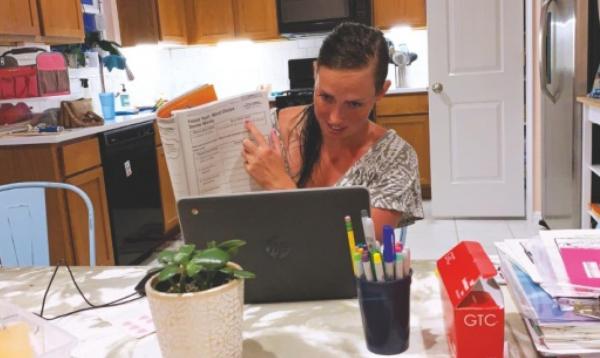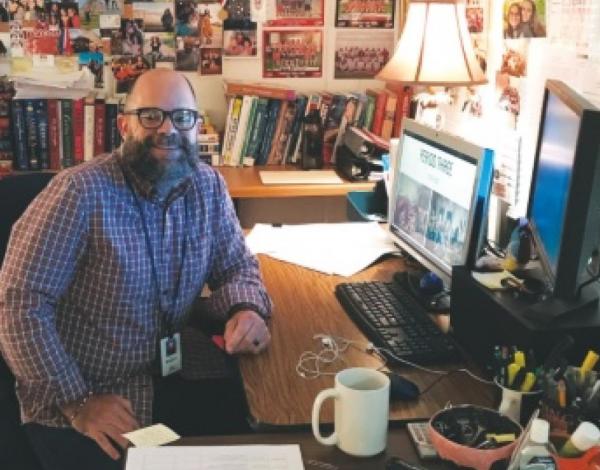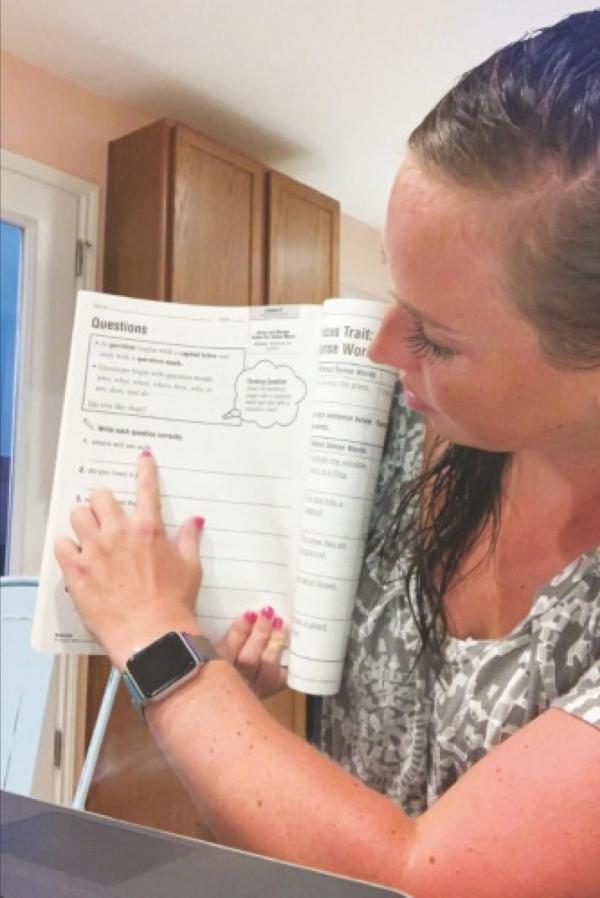Teaching outside of the classroom
How can the kids continue going to school is not a question for Wimberley ISD students. The easy answer, at least the teachers make it look easy, is online. Teachers still teach and students are still learning, despite being homebound.
Each of the schools have their own methods and the only thing really missing is being in the same room. Technology is a big help. The use of Zoom, an online program that allows you to see multiple people face to face, is a way to reach the kids. There is plenty of other technologies used too.
Brad Biggers, at Wimberley High School, teaches Advanced History and is the UIL Advisor. “It’s a challenge,” Biggers said. “The Google Suite and the Google Classroom are indispensable. Every kid has a phone or Chromebook (a tablet) that is supplied by the school. Access is everything.” Google has an app that is similar to Zoom.
“They see me on the right, with a slide on my left, just like a classroom. They can see me and ask questions, and view a You tube video… they have access to the teacher.”
There are some areas that are not optimum, though. “Some students don’t have reliable internet… it can take 20 minutes to download a two minute video.” His classes are 11 a.m. to 12 p.m. and 1 to 2 p.m. The presentations are recorded. “If you couldn’t watch it in Google Classroom, the questions can’t be answered live. But they can email the questions.” The system is working.
“One of the good things, if this happened in 2010, I can’t imagine how frustrating that would be… (today) it can be seen in real time, just like we were in the classroom. Better than just reading a book. There’s more of everything and there’s interaction thanks to the technology.”
All the technological tools available will be used by Biggers in the next few weeks. Getting his students prepared for the Advanced Placement History test on May 15 is now his main thrust.
At Danforth Junior High, Nicole Royal teaches 6th to 8th grade English. “It’s been an interesting process and has been easier as the weeks have gone by,” she said. The English Department at the junior high has pooled their resources, and we have new curriculum and have had to scrap everything we had for the year.”
Her students receive lessons both digitally and on paper. Both are “valid. Some have the connectivity. There are some students with special accommodations,” she said. “They need to have the material read to them. The department is respectful of that… respecting the boundaries of the family.”
But there are lots of new issues to deal with. “Remember they have other classes, and the kids are dealing with motivation issues.” Every two weeks packets are distributed. Danforth also uses Google’s digital classroom with parent access.
Either way, digital or paper, “most everything is equitable.”
Varying the projects also helps to keep the boredom down. ”We’ll have a novel due, then the next two weeks a pandemic journal, daily and a paper on it. They can express themselves on that… then grammar for a couple of weeks for the next level.”
She also has videos assigned. “My videos have been mainly motivational, a way to connect emotionally and keep the students engaged… Zoom meetings are mostly of the social and emotional aspect. Just letting the kids talk and answer questions.” The whole experience has been a different one.
“It’s an interesting challenge… we’re lucky in Wimberley and appreciative of each other… everyone has been so patient and grateful.”
April Grant teaches third grade at Jacob’s Well Elementary. “We’ve done some different things. The biggest goal on our team is to keep it simple.” Just like at the other grades, packets are distributed every two weeks for use digitally or on paper. “Be flexible.” They use the Google Classroom for assignments with Google linking up to math programs. “Just click on the links, keep it simple.”
They use Zoom three times a week, trying to keep the teacher/student relationship intact. “There’s feedback from the kids, keeping the relationships and connections with the kids, (so that they remember) ‘Oh yeah we’re still in school,” Royal said. “I’ve sent them on scavenger hunts and writing ‘thank yous’ to healthcare workers.”
One problem, just as it is for the other schools, is connecting to the Internet when mom and dad are working at home and siblings using it for their work. “It can be overwhelming for the students. Let it go if it is stressful and do it later,” she’ll tell her students.
“There’s definitely an adjustment. I miss the kids. It’s just sad. I want to see them in person and hug them. For all the teachers the biggest struggle is wanting to be with the kids.”
Emily Merkord at Scudder is pleased about the technology. “About five years ago, I got familiar with the Google Suite, from the get go. The district has been a great support.” Her class’ students are seven years old. “Each WISD student gets a Google email account from kindergarten that will become apparent when they get older.” Google Classroom again is the technology of choice.
“The kids get to see their friends, and their assignments. They get slides and drag and drop into place assignments. I create different things for a theme… we use Zoom and Google Chat…I’ve let them create their own emojis.”
Emojis are cartoon like pictures used in text messages such as a smiley face.
Their packets are not on the Internet though.
She has her own YouTube channel where, “I record myself at my own pace as if I was not on YouTube. Like how to organize their day… I’m live four days a week, typically Monday through Thursday at 11 a.m.. I love Google; there are so many stories in the Cloud. Parents can get on and toggle around. It’s wonderful.” She also reads to them, remember they’re only seven. She records things at home and present stories like dressing pets in costume, something she’s done. “Kids love what teachers do at home,” she said. “At first it’s a struggle if the parents are used to Yahoo… It doesn’t look easy, but once you are used to it, it is flowing,”
As for herself, “I’m learning new skills for school, how to convert videos, putting your mic on for voice… It does keep me busy… just get on the wild horse and learn from it. At first it was hard on the kids. Now it’s just been a good change. I still reach out to teach them and the kids are learning.”
And as for that teacher/student relationship, “I adore to see them on Zoom. I send them postcards every week, and I phone to check on the parents. I also take lots of pictures and exchange them. I try to keep a lot of communication with the students as much as I can.”
As much as the quarantine has disrupted daily lives, some good has come from it. Learning new skills that can be incorporated into the daily classroom once the world returns, to a new normal.




